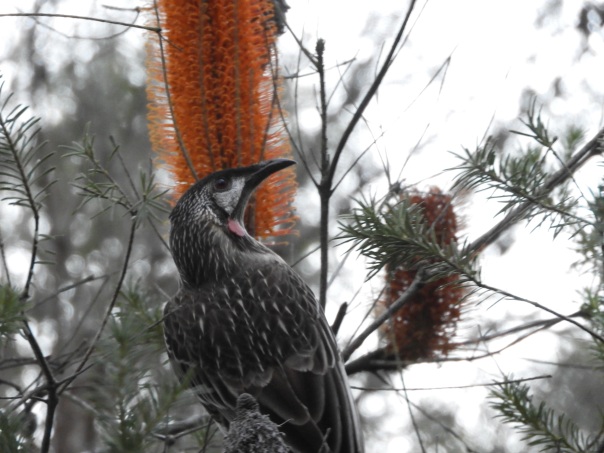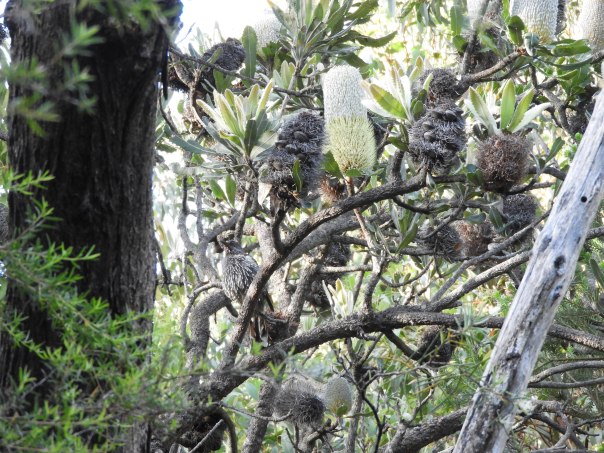Category Archives: Wattlebird
Big baby! Koel cuckoo fed by Red Wattlebird
It’s cuckoo season here on the east coast of Australia. We have several types of cuckoos that migrate to our shores for the summer months and get the local birds to feed their young. That’s right! Cuckoos lay their eggs in some other bird’s nest and fly away free as a … well, as a bird. The adoptive parent is often much smaller than the baby cuckoo, but it’s hornswoggled into feeding the youngster until the cuckoo is old enough to take care of itself.
One of the cuckoos that come to our shores is the Common Koel, also called the Eastern Koel. A couple of days ago, I saw a young Koel being fed by a Red Wattlebird:
In the video, you can hear the juvenile Koel chirping repeatedly, begging for food.
Here’s a photo of the big baby:

Adult Koels make quite a variety of sounds, including loud squawks and more melodic whistles. You can hear them in the video in this post. And you can see some shots of male and female adult Koels in other posts.
Common name: Common Koel, Pacific Koel, or Eastern Koel
Scientific name: Eudynamys orientalis (was scolopacea)
Approximate length: 45 cm
Date spotted: 3 December 2025 (summer)
Location: Manly Dam Park, New South Wales, Australia: 33°46’57.5″S 151°15’20.8″E
Little Wattlebird bathing in the tree tops
A Little Wattlebird, high in the gum trees, dives through the leaves. I’ve seen birds doing this a few times. They’re taking advantage of the early-morning dew to freshen up their feathers.
Here’s a still photo of the Little Wattlebird:

Common name: Little Wattlebird
Scientific name: Anthochaera chrysoptera
Approximate length: 30 cm
Date spotted: 1 April 2024 (autumn)
Location: Manly Dam Park, New South Wales, Australia: 33°46’39.6″S 151°14’55.7″E
Little Wattlebird on Old Man Banksia
In the early morning light, this Little Wattlebird sits among the sunlit leaves of an Old Man Banksia tree.
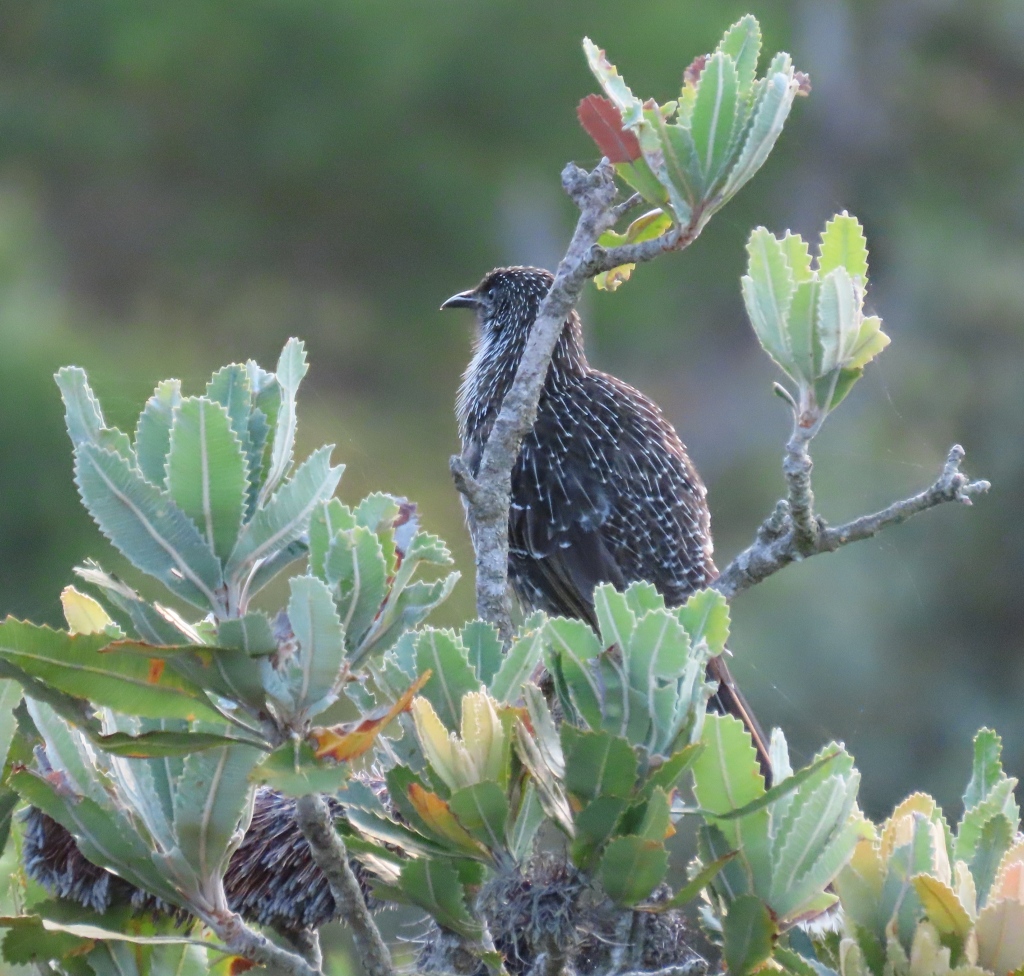
Common name: Little Wattlebird
Scientific name: Anthochaera chrysoptera
Approximate length: 30 cm
Date spotted: 17 February 2024 (summer)
Location: Dobroyd Head Track, Balgowlah, New South Wales, Australia: 33°48’33.2″S 151°16’14.1″E
Soft colours of a young Little Wattlebird
This bird was busy gathering food on an Old Man Banksia tree (Banksia serrata). It has a small insect in its beak:

I think the bird is a Little Wattlebird, though others that I’ve seen have been darker and greyer in colour. Perhaps it’s a juvenile. I considered an oriole, but the stripes on this bird’s chest are more like those of a wattlebird than an oriole, and the shapes of the beak and head are closer to those of a wattlebird too.

Little Wattlebirds don’t have the red wattles that give this genus its name. These birds are classified as honeyeaters, but like most honeyeaters they’ll grab a passing insect too. This bird was at Dobroyd Head, one of the pieces of land that jut into Sydney Harbour.
Here’s a view that shows more of the wings and back:

Common name: Little Wattlebird
Scientific name: Anthochaera chrysoptera
Approximate length: 30 cm
Date spotted: 11 March 2023 (autumn)
Location: Dobroyd Head Track, Balgowlah, New South Wales, Australia: 33°48’33.2″S 151°16’14.1″E
Call of the Red Wattlebird
This Red Wattlebird was quite chatty in the crisp morning air.
Usually when walking in the bush I hear the more raucous croaks of this bird and its cousin, the Little Wattlebird. So it was nice to hear something a little more melodious.
Here’s a still picture of the Red Wattlebird, showing the red flap below its eye which gives the bird its name:
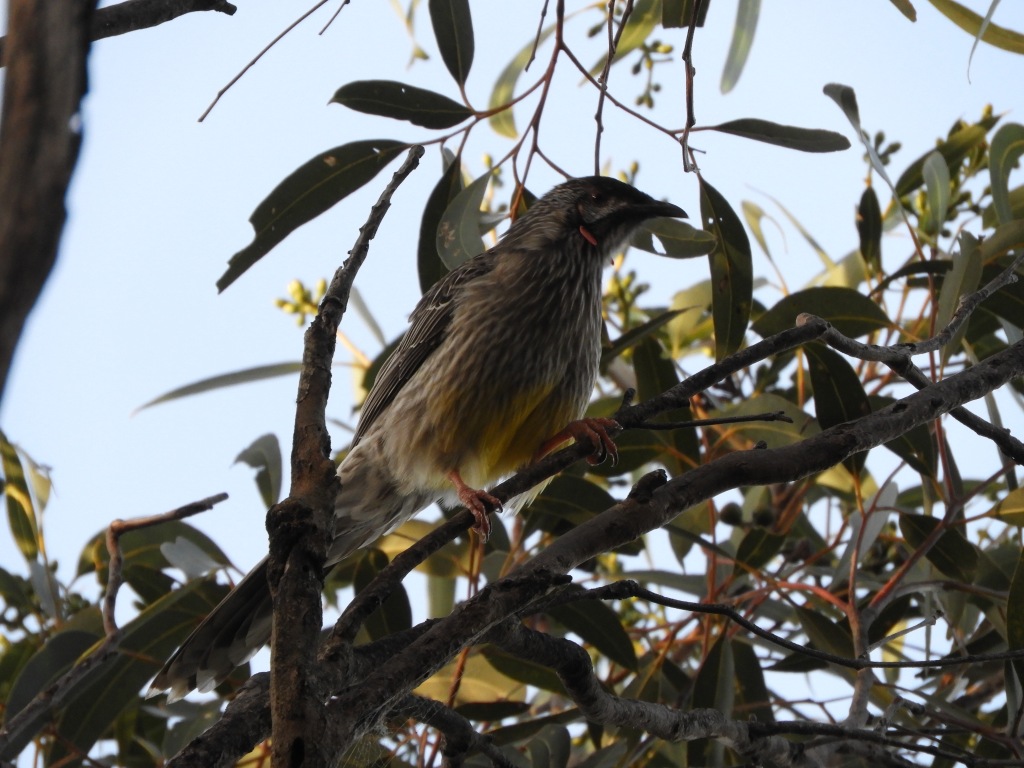
The feathers on its back are quite decorative, and a sun ray lights up the yellow on the bird’s belly:
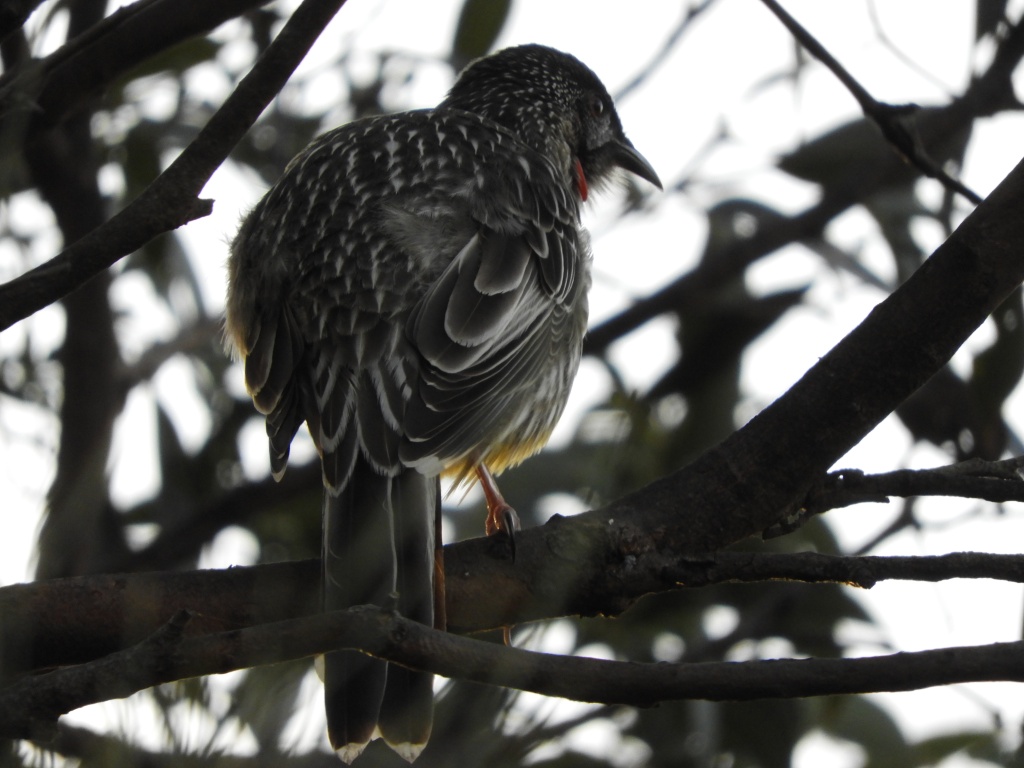
Common name: Red Wattlebird
Scientific name: Anthochaera carunculata
Approximate length: 35 cm
Date spotted: 24 April 2021 (autumn)
Location: Manly Dam Park, New South Wales, Australia: 33°46’10.0″S 151°14’53.6″E
Red Wattlebird on Banksia
Red Wattlebirds are large, noisy honeyeaters. They get their name from the red flaps of skin below their eyes. This one was feeding on the nectar of a Heath Banksia flower:
The next picture shows both wattles on the bird’s neck:
Common name: Red Wattlebird
Scientific name: Anthochaera carunculata
Approximate length: 35 cm
Date spotted: 18 July 2020 (winter)
Location: Manly Dam National Park, New South Wales, Australia. Approximate map reference: 33°46’27.0″S 151°14’57.6″E
Little Wattlebirds are common in the area too. The two birds can be hard to tell apart. Red Wattlebirds are larger (approx 35 cm from head to tail) whereas Little Wattlebirds measure approximately 30 cm. Little Wattlebirds don’t have the large red wattles. Here’s a Little Wattlebird that I photographed a while ago:
Wattlebirds’ tree bath
I’ve seen various birds dive through the treetops to clean their feathers. From the small New Holland Honeyeaters to the much larger King Parrots., they do it in the early morning to catch the dew, or after a rainfall. Today I managed to catch a couple of Wattlebirds performing their ablutions:
Common name: Little Wattlebird (see more pics of this bird)
Scientific name: Anthochaera chrysoptera
Approximate length: 30 cm
Date spotted: 20 April 2019 (Autumn)
Location: Manly Dam National Park, New South Wales, Australia: 33°46’16.5″S 151°14’53.5″E
Ninja wattlebird – now you see it now you don’t
Spot the bird:
It’s a common sight to see a Little Wattlebird on a banksia flower, digging its beak between the florets to find the nectar. I hadn’t realised until now, though, how perfectly camouflaged the bird is on the grey branches of a mature banksia, particularly when surrounded by dead flowerheads.
Here’s a closeup pic of the bird, looking supremely confident though, dare I say it, not very well groomed:
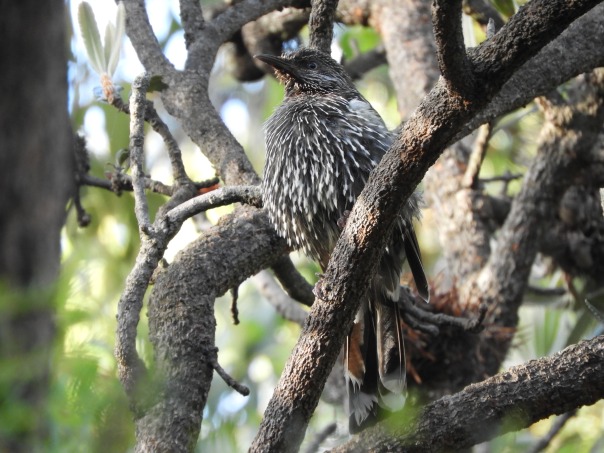
These are the flowers of the Banksia Serrata tree where I saw the bird:
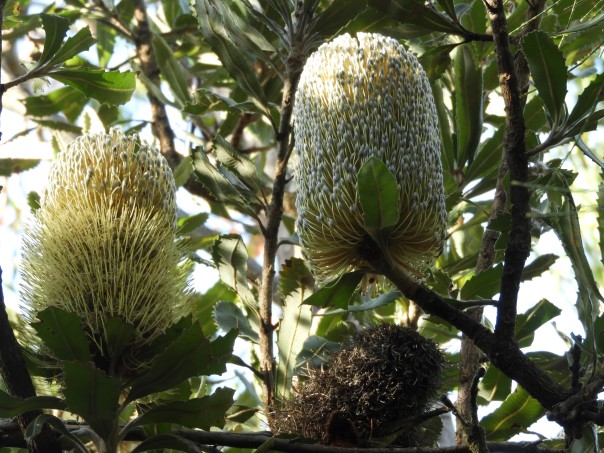
The wattlebird later moved to a bare branch to do a bit of grooming. Caught in dishevelled silhouette against the morning sun:
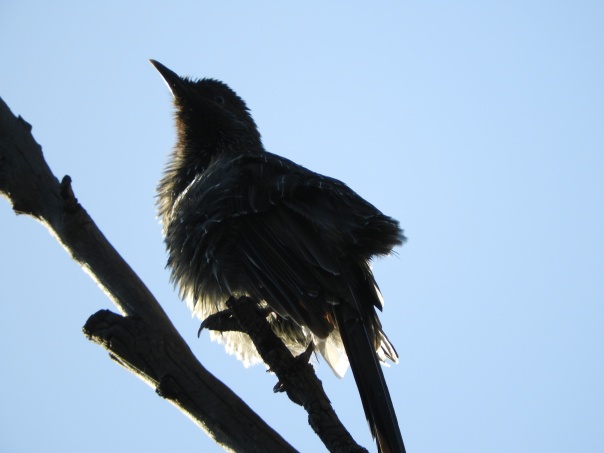
Common name: Little Wattlebird
Scientific name: Anthochaera chrysoptera
Approximate length: 30 cm
Date spotted: 26 December 2018 (Summer)
Location: Manly Dam National Park, New South Wales, Australia: 33°46’15.4″S 151°14’45.0″E
Red Wattlebird eating lerp
Red Wattlebirds are large honeyeaters, often seen diving through the foliage and chasing other birds away from a prized source of sugar. This one was making a lot of noise crashing through the branches. Probably on a sugar high. I think the white fuzzy stuff attached to its beak is lerp – crystalised honeydew exuded by bugs as a protective covering. A sweet treat for a bird. Red Wattlebirds get their name from the red wattles hanging below each cheek.
Common name: Red Wattlebird
Scientific name: Anthochaera carunculata
Approximate length: 35 cm
Date spotted: 11 November 2018 (Spring)
Location: Manly Dam National Park, New South Wales, Australia: 33°46’36.6″S 151°15’17.9″E
Little Wattlebird calling, mate unimpressed
A male Little Wattlebird does its best to impress (or intimidate) the bird sharing its branch. The other bird is unimpressed. In fact, its reaction seems to be, “Oh, please, are you really going to keep doing that?”
The call of a Little Wattlebird is strange. It often starts with a click-clack, as if the calling mechanism is turning over before getting into full gear. Then out comes the harsh bray that’s characteristic of the male bird. It seems to take a fair bit of effort to make this noise, as you can see in the video:
I went back to the same spot a day later, and snapped a picture of this male Little Wattlebird. It’s probably the same bird, given their fierce territoriality:
Common name: Little Wattlebird
Scientific name: Anthochaera chrysoptera
Approximate length: 30 cm
Date spotted: 7 July 2018 (Winter)
Location: Manly Dam National Park, New South Wales, Australia: 33°46’36.9″S 151°15’10.4″E





